Microsoft
Microsoft Precision Mouse: a comfortable Bluetooth mouse for office use
Aprox. 69€ - see price -
See specificationsDesigned to provide maximum comfort to those who work long hours on their computers, the Precision Mouse from Microsoft is positioned in a rather high-end niche. Let's see if she's good enough.
Positive points
Comfortable grip.
Manufacturing quality.
Disengageable wheel pleasant to use.
6 configurable buttons.
Smart Switch function to switch from one computer to another automatically.
Good autonomy.
Bad points
The sensor could be faster and more precise.
Sliding quality just right.
Configuration software incompatible with macOS.
Our review
Presentation
The Precision Mouse is available in black ("Black Edition") or gray ("Surface" edition, named after the devices in the range with the same hues). It was launched at the recommended retail price of € 109.99.
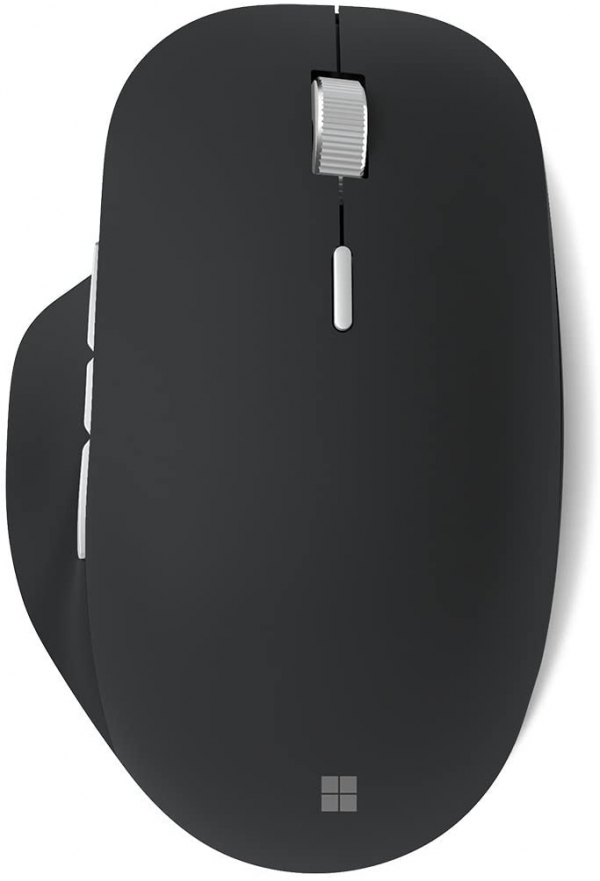
Ergonomics
If Microsoft does not necessarily make the news with its mice, it is not new to the subject and even has a certain notoriety with regard to ergonomics. The Precision Mouse takes advantage of this experience and perfectly hugs the curve of the hand despite a fairly simple shape in appearance and a sleek design.
It is thus more classic than an MX Master 2S from Logitech, for example. Unlike the latter, its size is also more common and probably adapts better to small hands. The Precision Mouse is indeed much lower (43.3 mm, or 5.1 mm less), but also less wide (77.6 mm, against 85.7 mm) and shorter (122.6 mm, against 126 mm) than the Swiss mouse. However, this is enough for large hands to rest their entire palm without the fingers sticking out of the buttons, thus ensuring a certain level of comfort and less fatigue.
The grip is improved by the non-slip material covering the slices of the mouse. A touch of eraser very pleasant under the fingers elsewhere, although a little messy, which echoes the softness of the plastic used on all the rest of the mouse. The finishes are in any case very neat, there is nothing to complain about. The thumb benefits from a small overhang which prevents it from rubbing on the desk and fits naturally in the hollow of the left edge. These ergonomic details make the mouse easy to move and even to lift if necessary (to center it on the desk, for example), especially since, without being light, it does not suffer too much from its 138 grams. It is in any case more maneuverable than the MX Master with its 149 g. The Precision Mouse remains an office mouse, however, and is not designed to be moved around vigorously, as you might do with a lighter mouse in a fast video game.
Regarding the buttons, Microsoft is not in the auction and is content to offer three on the left edge, in addition to the two main, that of the wheel and a seventh reserved for changing the scrolling mode of the latter. With the exception of this last button, all are configurable in the mouse software (see box) and can take other functions. By default, the slice buttons are used for the navigation functions: "next page", "previous page" and "task display" - the latter is assigned to the middle button and is equivalent to the shortcut "Windows key" + "Tab" .
The main buttons are reactive at will and are quite firm. We measure the force necessary for their activation at around 50 cN. Appreciable for those who do not want to risk involuntary activations, but offering less flexibility than those of the MX Master 2S (35 cN), for information. It's up to you to choose what you prefer.
During our last mouse tests, we felt a difference in resistance of the main click buttons more marked than usual ...
Unlike the main ones, the slice buttons do not benefit from mechanical switches, but their contact switches offer a good touch and are less noisy.
The wheel button is also nice and activates easily with a thud. But the most interesting is at the level of the wheel itself, since it is disengageable! We can thus choose between a notched mode and a smooth scrolling mode, without notch, simply by pressing the dedicated button, located just above. Precision is at the rendezvous and it is a treat to handle this wheel in one mode as in the other. However, it is not as advanced as the disengageable dial of the MX Master, since it has no inertia and cannot rotate several turns with a single pulse of the finger. It is therefore necessary to accompany him permanently to scroll through a document; you cannot go down several pages at once or even all the way down a document with a single gesture. We console ourselves nevertheless with its better stability.
In terms of gliding, the single pad running all around the underside of the mouse unfortunately does not reduce friction enough compared to the PTFE pads that are usually found under competing mice. This results in a slightly higher friction noise and less fluid movements. It is better to use the mouse with a fairly high sensitivity to avoid large movements which could pull the wrist more quickly. The mouse is also more comfortable on a hard surface than on a flexible textile mat, for example.
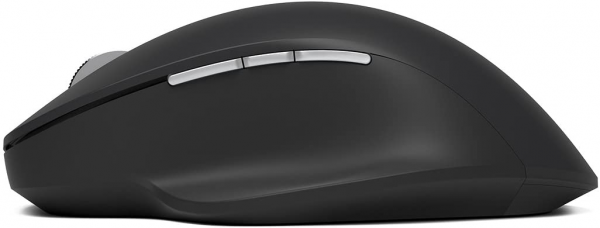
Precision
The Precision Mouse's bluetrack optical sensor has the advantage of working on a wide variety of surfaces. Even glossy coatings are accepted and we have managed to get the mouse to work on certain glass surfaces as well. This good capture does not happen without some compromises, however. We remain indeed on our hunger as for the precision of the mouse on the micro-movements, the follow-up thus not seeming to be done pixel by pixel. Nothing too annoying in purely office use, but somewhat disabling on photo editing and other work precisely requiring great precision.
In addition, we can observe a small latency which, here again, does not particularly disturb in office automation, but makes the movements of the mouse a little heavy and excludes its use in video game. The speed of the sensor is in any case insufficient for rapid games, it easily picking up on rapid movements.
The sensitivity is adjustable in steps of 200 between 400 and 3,200 dpi. Sufficient to use the mouse even on Ultra HD monitors.
Wirelessly, the mouse can only work in Bluetooth (4.0 or later). Microsoft does not offer a USB radio adapter on this model. The Precision Mouse can nevertheless be paired with three computers and then switch from one to the other with a simple press of the button located under the mouse. Even better, the Smart Switch function allows you to automatically switch to another computer by bringing the pointer out of the screen. You just need to configure the function in the "Microsoft Mouse and Keyboard Center" software previously installed on each computer, indicating in particular the position of the PCs and the desired sensitivity level to switch from one to the other. This software is unfortunately not macOS compatible, it is not possible to really take advantage of this function with Apple computers. The mouse can work on these, but when you switch on it with the Smart Switch function, you can then return to a PC only by manually changing the channel with the button under the mouse. Note also that the scrolling wheel is reversed on macOS compared to the "normal" operation of other mice.
Question autonomy, Microsoft announces three months of use with a full charge of the Li-ion battery. Rather reasonable endurance, which we could not measure, however, because we could not test the mouse over such a long period. However, the steady decrease in the percentage displayed by the charge level indicator seems to correspond to this indication.
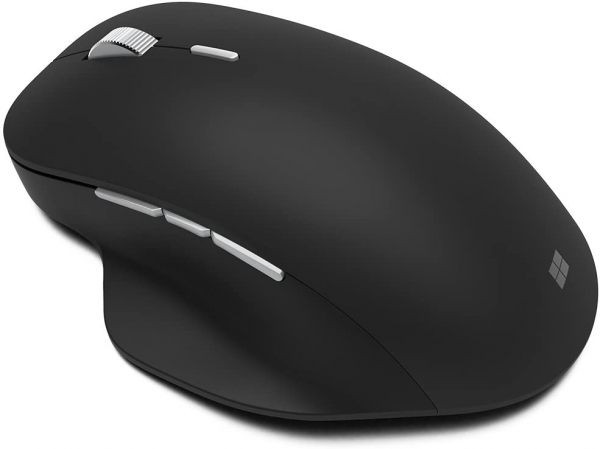
Conclusion
For purely office use, the Precision Mouse is quite satisfactory. It nevertheless competes with the MX Master 2S from Logitech, more successful, but also more imposing. If you prefer slightly thinner mice and only use Windows PCs, this Microsoft mouse is still interesting.
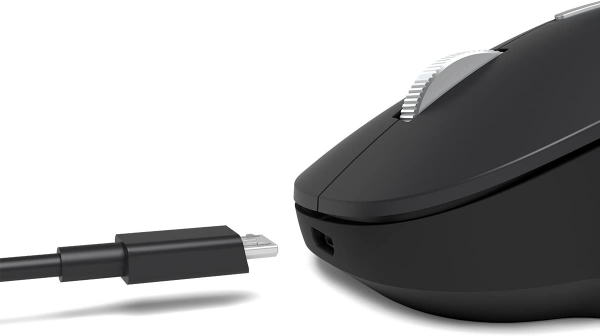
Specifications
Reviews

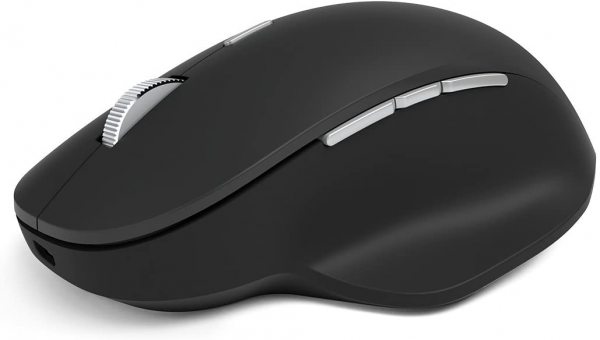
A lot better than what I'm used to
This is the most expensive mouse I have ever owned. Been using it for about a week now and the switching between using it for my laptop and to my PC is as seamless as it gets. The plastic shell, while not something I'd expect on a 100 $ mouse, feels far, far more better than the 10-20 $ mice I'm used to. The connection on it is so good that I couldn't even see the difference between wired or wireless. No sign of degradation of the connection or hiccups whatsoever.
The middle button below the mouse-wheel allows you to switch between wheel-scrolling modes. It can turn to be either real smooth-like or normal. While I like knowing that my mouse has such a feature, the smoothing feature feels far too weird to ever actually use.
Would I recommend this? If you use a computer a lot, definitely.
terrible glide; UPDATE; USB connection housing broke!
The structure of the bottom of this mouse is such that the whole base perimeter touches whatever surface you are using, causing friction with every movement. There is no glide-friendly material on this mouse. If you are busy and need to do a lot of mouse work, this will make a pretty paper weight while you use a mouse that actually glides more freely. There is no software trick or changes in Microsoft's Mouse & Keyboard Center application that will overcome the hardware engineering challenge that Microsoft is selling to the public. Microsoft is selling a poor value proposition in what has quickly become a strange product because of it.
UPDATE March 19, 2019: I was connecting the USB cord to the mouse today and as the connector secured itself in the housing, the housing broke. This is an all-around shoddy piece of engineering.
Works on GLASS!
This is a wonderful step up for a Microsoft Mouse. I last had a "Bluetooth Sculpt Touch" mouse --which had "Bluetrack" technology that worked on everything BUT glass. I know Logitech had this feature years ago, but this is the 1st Microsoft mouse I've had that works well on my glass tabletop, so no mousepad needed --- ever. I have 2 Windows 10 laptops that I use at work. The mouse is amazingly good at auto switching between the two computers. It is not perfect, but there's also a tiny switch on the bottom with an indicator light highlighting which computer the mouse is connected to, and you can easily switch using the button. What is interesting is that you can have different mouse resolutions on each computer. I use one computer for certain programs, and the other for different programs. It is a great convenience to have different resolutions - automatically. Some of my programs work better using smooth vertical scrolling, and others are better with the normal scrolling. There are 3 buttons on the left side and all are customizable. I charge my battery about once a week on a schedule; I haven't tried to find out the maximum battery length. When the mouse is connected to the charging cable (USB ---> microUSB) it becomes a wired mouse. The mouse is fairly large, but is perfectly designed to fit and remains comfortable after hours of use. I've only had this mouse a few weeks, but as other reviewers have commented on some reliability issues I decided to invest in the Assurian replacement contract for only about $ 10 for 4 years of guarantee. I have used Assurian services MANY times for all the phones in my household; when there's an issue they replace. Unlike my iPhone, for the mouse I did not see a service fee for replacement. To sum: this is the best mouse that Microsoft has ever made, and it pairs well with my Windows 10 computers.
Awesomeness!!
I just received this mouse and I'm already loving it! A nice substantial weight and feel with nice simple ultra-smooth lines and contours. The thing I notice most is how it places itself into your whole hand and then seems to allow your hand to melt right into it. The pleasantly weighted machined aluminum wheel is extremely smooth and responsive. The easily accessible thumb buttons are crisp and snappy and don't (unlike another extremely popular competitor) jam up against your thumb in a standard holding position. Also, if you shake the mouse it retains a solid firmness with no rattle from the parts or components - exactly what I expect from a high-end mouse at bare minimum. I will update this review as I continue to use it with such things are battery life, charging, holdup, etc. As of now I'm just really blown away with excitement and satisfaction from such an awesome example of ... awesomeness!
Works great, but ....
This does exactly what I wanted for work with Photoshop and Lightroom. It's precise and does exactly what you ask it to do. The Blue Tooth connected easily on the first try but disconnects every time the computer goes to sleep. After trying to figure it out for a couple of days (instructions are no help) I gave up and connected it with the USB cord.
Great To Use, But Annoying To Recharge
And you'll have to recharge it often. How often? Well, you need the Microsoft Mouse and Keyboard Center program to do that. Another annoyance.
great mouse
i have had this for awhile now. the battery last forever. i take it with me. its very comfortable. would buy again. you get what you pay for
Sad that this doesn't support Windows 7 in Bluetooth mode.
I know it does actually say that in the description, but I didn't notice it. There really isn't a sound technical reason for the Bluetooth mode of this mouse to be unsupported in Windows 7, but there you go. This mouse will probably sit in a draw until I am forced to upgrade my version of Windows.
Oh, and a non-replaceable battery. Why?
What a shame Microsoft canceled the "Microsoft Explorer Mouse", by far the best mouse they have ever made.